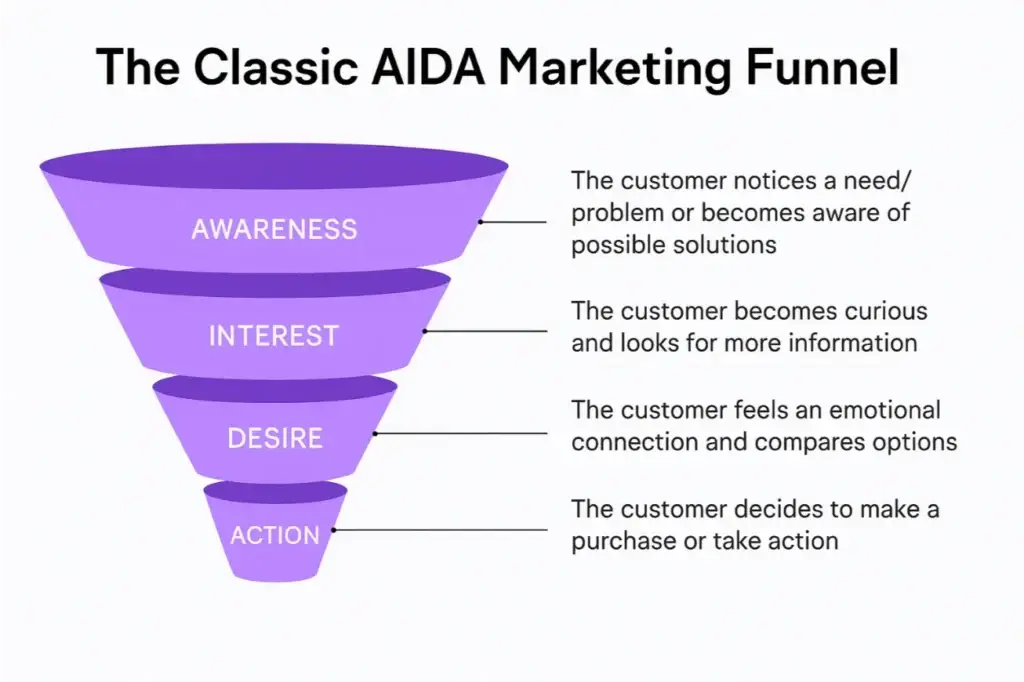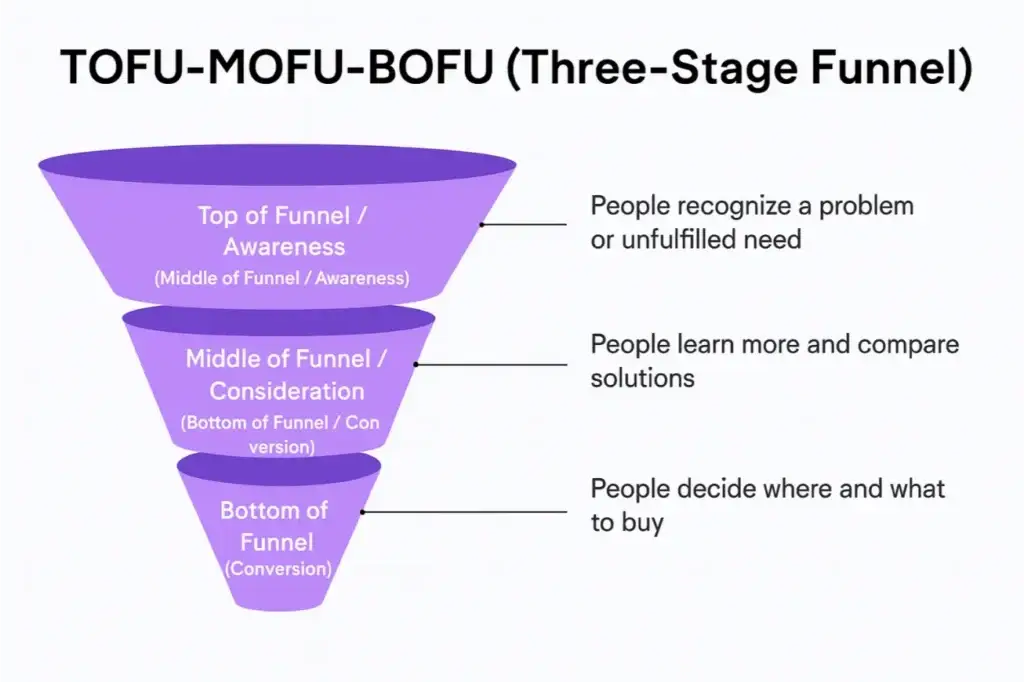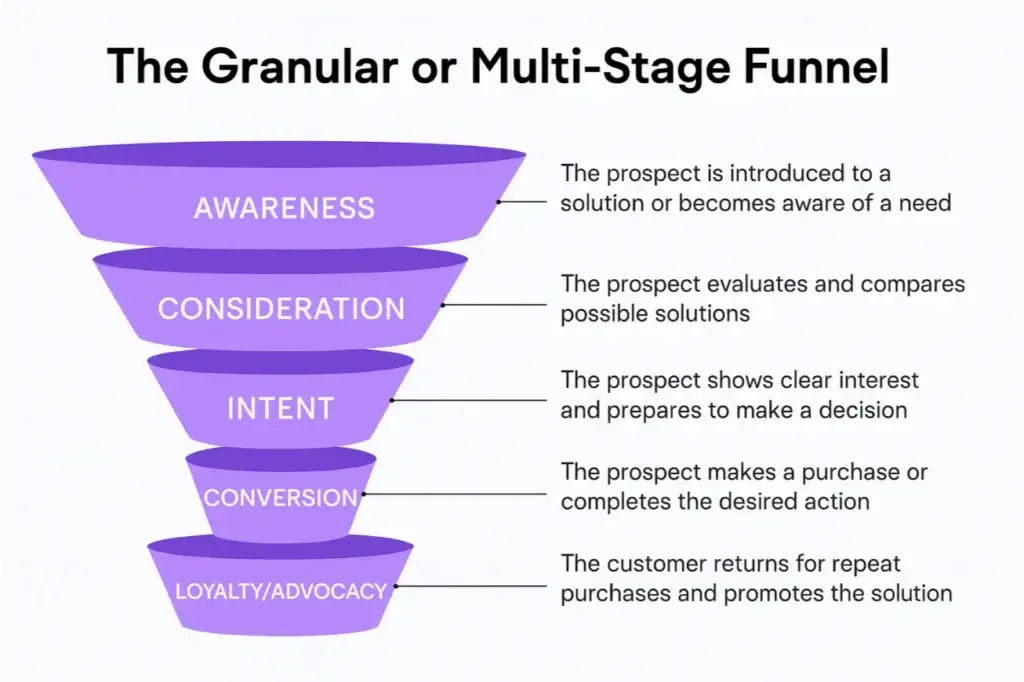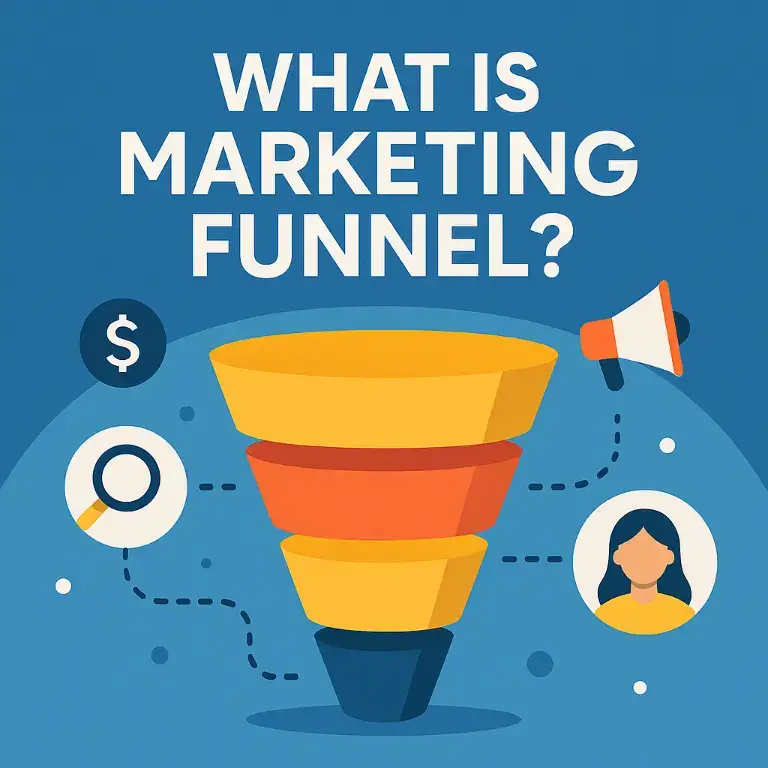Navigating today’s digital marketplace involves understanding how real customers find, evaluate, and ultimately choose your brand. The marketing funnel is a proven framework for mapping the customer journey, enhancing conversion rates, and fostering sustainable business growth. In this article, we’ll break down what a marketing funnel is, explain each stage in plain, actionable language, and show how psychology and data-driven strategies can help you succeed at every touchpoint.
Key Takeaway:
- A well-structured marketing funnel is essential for understanding and guiding the customer journey, from initial awareness to long-term loyalty and advocacy.
- Consumer psychology drives each funnel stage, and leveraging triggers like curiosity, social proof, urgency, and emotional connection can significantly boost conversion rates.
- Measuring the right KPIs at every funnel stage helps marketers identify bottlenecks, optimise strategies, and clearly demonstrate ROI.
- Modern digital funnels are dynamic and multi-channel; marketers must adapt to non-linear journeys, utilise data-driven insights, and continuously refine their tactics for sustainable growth.
What is a Marketing Funnel?
A marketing funnel is a thoughtful way to map out your customers’ journey, from when they first discover your brand, through considering your offer, to making a purchase and, increasingly, becoming loyal and even advocates for your business. The idea originates from the classic AIDA model (Awareness, Interest, Desire, Action), which has been guiding marketers since the early 20th century. While the terminology has evolved over time, the main aim remains the same: to gently guide prospects step-by-step towards taking a desired action.
Why Marketing Funnels Matter for Modern Marketers
A well-crafted marketing funnel provides brands with a clear way to guide prospects from their first point of contact to becoming loyal customers, making every stage easy to track and act upon. Recent studies from Nielsen show that boosting brand awareness by just one percentage point can increase sales by around 1%. Companies that adopt a full-funnel strategy blending long-term brand-building efforts with short-term performance tactics have seen their overall marketing return on investment grow by between 15 and 20 per cent. For those serious about maximising their marketing budget and truly understanding how buyers make decisions, mastering the marketing funnel is essential for long-term success.
3 Types of Marketing Funnels & How They Work
Different businesses and campaigns need different marketing funnel models. Here’s a quick overview of some of the most popular frameworks, each designed to reflect the real customer journey and offer practical guidance at every stage.
1. The Classic AIDA Marketing Funnel

The AIDA model describes the psychological journey customers go through before making a purchase:
- Awareness: The customer first becomes aware of a problem or need and notices possible solutions or brands.
- Interest: The customer develops curiosity, actively seeks more information, and explores whether a product or brand fits their needs.
- Desire: The customer forms a preference or emotional connection, starts to compare brands, and imagines owning or using the product.
- Action: The customer is ready to make a decision, complete a purchase, or take the intended action.
Example: Fitness App Journey
Imagine someone looking to get healthier stumbles across a new fitness app online:
- Awareness: Spots a friend’s social media post about the app and realises they want to improve their fitness.
- Interest: Check out online reviews and the app’s official site to see what features it offers.
- Desire: Compares the app to others, watches video testimonials, and envisions achieving personal health goals.
- Action: Decide to download the app and register to start a workout plan.
2. TOFU-MOFU-BOFU (Three-Stage Funnel)

This practical model maps how customers’ mindset changes as they move closer to a buying decision:
- Top of Funnel (TOFU) / Awareness: Customers become aware of a problem or discover a need. They may not know your brand yet, but they’re open to new ideas or solutions.
- Middle of Funnel (MOFU) / Consideration: Customers are evaluating options, comparing brands, and seeking more in-depth information to see what fits best.
- Bottom of Funnel (BOFU) / Conversion: Customers are nearly ready to buy; they’re weighing the final details and deciding where or what to purchase.
Example: SaaS Productivity Tool
A remote worker faces productivity issues and starts searching for better solutions:
- TOFU: Read an industry blog post about the challenges of remote work and potential tools for improvement.
- MOFU: Downloads a free guide comparing top productivity software and subscribes to an email list for tips.
- BOFU: Watches a product demo, reads customer reviews, and signs up for a free trial of the SaaS tool that stands out.
Curious how scarcity can boost your results?
📚 Discover proven tactics here: How to Use the Scarcity Principle in Marketing: Tactics Backed by Psychology and Data.
3. The Granular or Multi-Stage Funnel

Complex purchases or B2B sales often follow a more detailed journey with extra steps:
- Awareness: Customers recognise a challenge or opportunity and begin seeking solutions.
- Consideration: They actively research, compare options, and look for evidence or proof points.
- Intent: Customers show strong buying signals, such as requesting quotes or attending demos.
- Conversion: They make the final decision and complete the purchase.
- Loyalty/Advocacy: After making a purchase, satisfied customers are more likely to return to the brand or recommend it to others.
Example: B2B Cybersecurity Solution
An IT manager at a mid-sized company is tasked with improving network security:
- Awareness: Reads an industry report about the increasing risks of cyber threats and recognises a vulnerability in the company’s current system.
- Consideration: Attends a vendor-hosted webinar, reviews case studies, and researches several potential providers.
- Intent: Requests a tailored risk assessment and proposal from the top two shortlisted vendors.
- Conversion: Select a provider and sign a contract for implementation.
- Loyalty/Advocacy: After successful deployment, the manager shares positive feedback in an industry group and refers colleagues to the same provider.
The Psychology and Consumer Behaviour Behind the Marketing Funnel
| Marketing Funnel Stages: Customer Mindset, Questions, and Goals | |||
|---|---|---|---|
| Funnel Stage | Consumer Mindset | Key Questions Asked | Marketing Goal |
| Awareness | Curious, problem-aware | “What is this?” “Who can help me?” | Build recognition |
| Consideration | Evaluative, information-seeking | “How does this solve my problem?” | Build trust, educate |
| Conversion | Decision-focused, risk-aware | “Is this the right choice for me?” | Trigger purchase |
| Loyalty | Value-focused, post-purchase | “Should I buy again/recommend?” | Retain & activate |
Why do some marketing funnels perform better than others? The answer often comes down to psychology. Each stage of the funnel, awareness, consideration, conversion, and loyalty, corresponds with important consumer motivations and decision-making processes.
- Awareness is driven by curiosity and the need to solve a problem. At this stage, consumers are most receptive to new ideas, especially when messaging taps into their emotions or highlights shared values.
- Consideration involves active evaluation, where people seek information, compare options, and rely heavily on cognitive shortcuts, such as social proof. According to McKinsey, customer decisions are influenced by peer recommendations and third-party reviews more than direct brand messaging.
- Conversion often hinges on urgency, trust, and risk reduction. Psychological triggers, such as scarcity (“limited time offer”) and loss aversion (“don’t miss out”), as well as strong guarantees, can nudge buyers into action.
- Loyalty and advocacy are built on emotional connections, positive experiences, and the consistent delivery of value. Studies show that brands that invest in building relationships rather than just driving transactions enjoy higher retention rates and more referrals.
By understanding the motivations, biases, and emotions that drive each click or purchase, marketers can craft messages and experiences that naturally guide customers from initial discovery to advocacy.
Want to learn more about why people hate missing out?
📚 Read our in-depth guide: What Is Loss Aversion? A Complete Guide to the Psychology of Fear and Decision-Making.
How to Measure Marketing Funnel Success
To maximise your marketing ROI, it’s important to keep an eye on the right metrics at every stage of the funnel. Here’s how to measure success at each key point along the way.
1. Awareness (Top of Funnel)
- Key Metrics: Impressions, reach, website traffic, social shares, brand lift
- What to Look For: Are new prospects noticing your brand and content? Are you building a broader audience?
2. Consideration (Middle of Funnel)
- Key Metrics: Engagement rate, time on site, content downloads, email sign-ups, lead quality
- What to Look For: Are prospects showing deeper interest and interacting with your content? Are they moving closer to a buying decision?
3. Conversion (Bottom of Funnel)
- Key Metrics: Conversion rate, cost per acquisition (CPA), sales volume, demo requests
- What to Look For: Are leads turning into paying customers efficiently? Are you optimising spend versus returns?
4. Loyalty & Advocacy
- Key Metrics: Repeat purchase rate, customer lifetime value (LTV), Net Promoter Score (NPS), referral count
- What to Look For: Are customers coming back and recommending your brand to others?
Don’t rely solely on a single metric or the “last-click” approach. Instead, consider using multi-touch or data-driven attribution models to gain a clearer understanding of how each marketing touchpoint impacts the customer journey.
By regularly checking these KPIs, you’ll be able to identify any bottlenecks, adjust your strategies, and demonstrate the return on investment for your funnel, stage by stage.
Digital Marketing Funnel vs. Traditional Funnel
The traditional marketing funnel was designed for a simpler time, linear, one-way, mainly guiding customers from awareness to purchase through a set series of steps. However, today’s digital landscape is much more complex. Customers flick between channels, research brands at their own pace, and place just as much trust in peer reviews and online communities as they do in brand messaging.
Traditional marketing funnels tend to follow a linear path: awareness, interest, desire, and action. In the past, marketers had control over most touchpoints, and getting consumer feedback was often a slow process. Nowadays, the digital marketing funnel is much more fluid and non-linear. Consumers will enter and exit at different stages, revisit steps, and are influenced by a variety of factors, from search engines and social media to influencers and customer reviews.
Measurement has also advanced significantly. While traditional funnels tend to focus solely on final sales, digital funnels now require tracking smaller conversions, such as downloads, shares, or repeat visits, across various channels. Success nowadays depends on data-driven optimisation, multi-touch attribution, and maintaining ongoing engagement even after the initial sale.
| Traditional vs. Digital Marketing Funnel: Key Differences | ||
|---|---|---|
| Aspect | Traditional Marketing Funnel | Digital Marketing Funnel |
| Structure | Linear, one-way progression | Non-linear, dynamic, multi-channel |
| Customer Journey | Predictable, step-by-step | Fluid customers enter/exit at any stage |
| Main Influences | Brand ads, sales reps, and in-store experience | Search, social media, influencers, peer reviews, content |
| Feedback Speed | Slow, delayed (post-purchase surveys) | Instant, real-time (reviews, social mentions) |
| Measurement | Focus on the final conversion (sale) | Tracks micro-conversions, multi-touch attribution |
| Optimization | Periodic (campaign-based) | Continuous (real-time data, A/B testing, ongoing content) |
| Customer Role | Passive recipient of messages | Active participant and advocate |
Conclusion
The marketing funnel isn’t just a trendy term; it’s a practical, data-informed way of understanding and guiding customer behaviour in a world filled with endless options. Today’s success depends on combining psychological insights, measurement techniques, and creative content strategies at every stage, through every channel, and at every touchpoint.
FAQ
A marketing funnel is a strategic model that charts the customer’s journey, from initially discovering a brand to making a purchase and eventually becoming a loyal supporter. It helps businesses understand, influence, and fine-tune each stage of the buying process.
The marketing funnel is essential because it helps brands understand how to reach new audiences, nurture leads, and turn prospects into customers in today’s busy, multi-channel digital world. It also makes it easier to measure results and track return on investment at every touchpoint.
The main stages usually involve Awareness (catching people’s attention), Consideration (weighing up options), Conversion (making a purchase), and Loyalty or Advocacy (coming back for more and recommending it to others). Some models include extra steps for more detailed tracking.
Consumer psychology influences decision-making at every stage. For instance, awareness tends to be sparked by curiosity, consideration is often swayed by social proof, and the final push to convert typically comes from a sense of urgency or a desire to minimise risk. Loyalty, on the other hand, is built through emotional connection and offering consistent value.
A traditional marketing funnel tends to be a straightforward, step-by-step process, whereas a digital marketing funnel is more flexible and spans multiple channels. Nowadays, buyers can move between different stages, do their own research, and rely heavily on online reviews and social media.

